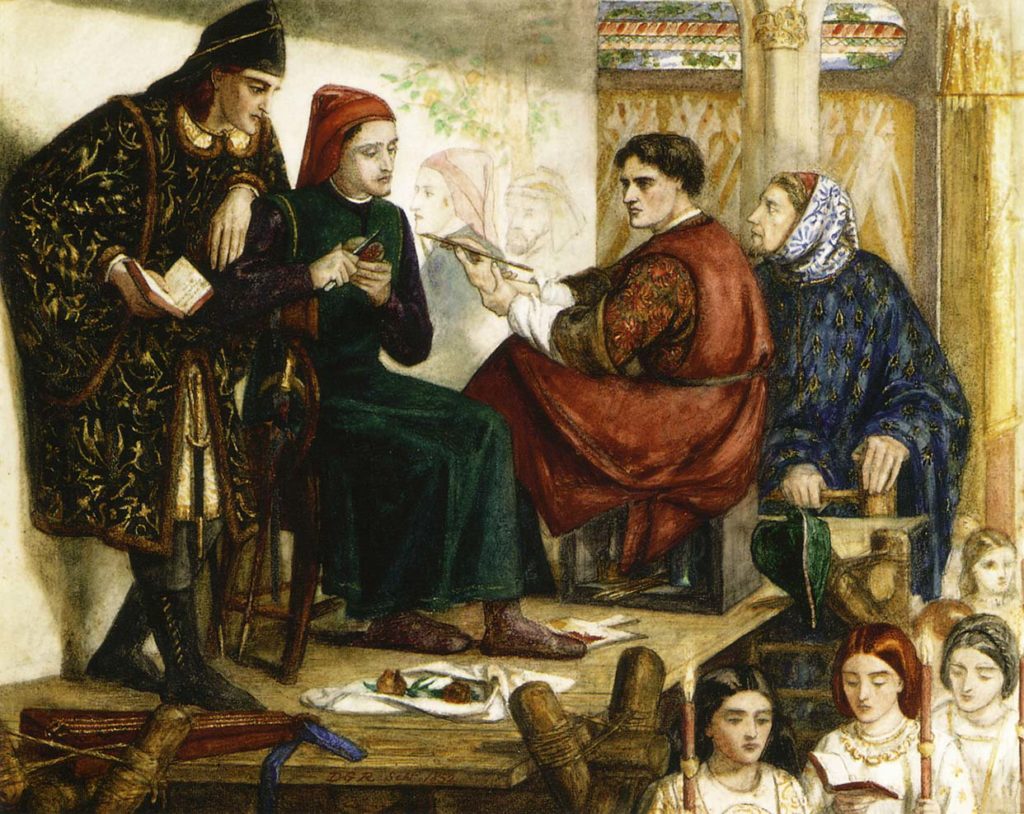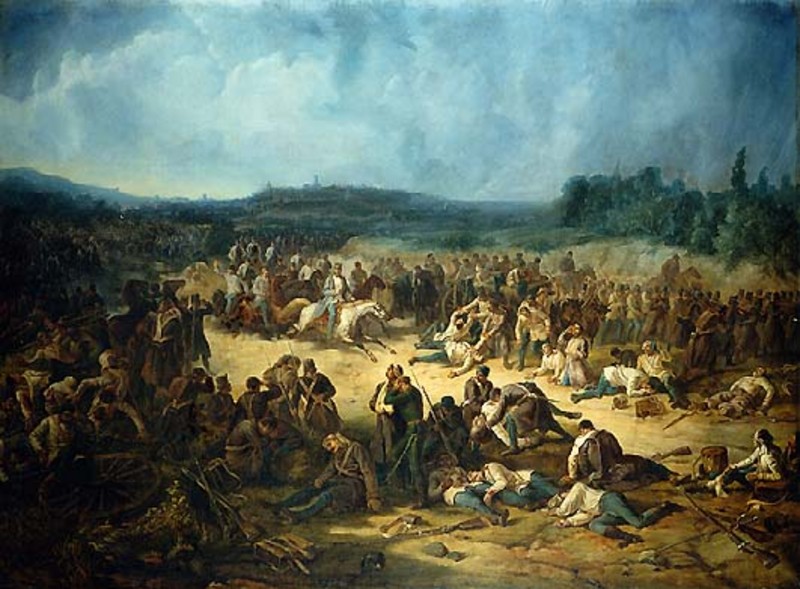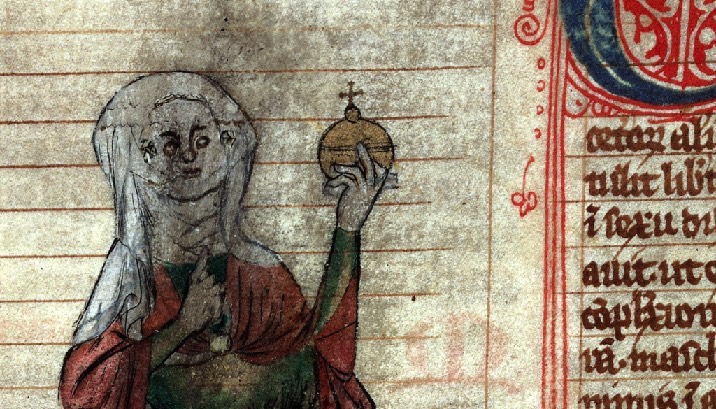
Dante e l’invenzione della lingua italiana

“Gli italiani parlano italiano”. É ovvio. Eppure, non molto tempo fa, non c’erano né “italiani” nel modo in cui lo comprendiamo oggi; e nemmeno c’era una sola lingua “italiana”. In effetti è poco conosciuto, che quando finalmente nel 1861 italia è divenuto paese, c’erano solo circa il 2,5{c84781dca76076c2df837abb441bfc3b29951050b7a36b48c8ddc8b88155ee2c} della sua popolazione che parlavano ciò che oggi chiamiamo italiano. Anche fino al 1951, meno del 20{c84781dca76076c2df837abb441bfc3b29951050b7a36b48c8ddc8b88155ee2c} degli italiani utilizzavano italiano esclusivamente nella vita quotidiana. Infatti, fino alle ultime generazioni, l’italiano era, al meglio, una seconda lingua per la maggior parte degli italiani. La loro prima lingua era la loro lingua regionale, e spesso locale. L’Istituto Nazionale di Statistica ha riferito che entro il 2012 il 53{c84781dca76076c2df837abb441bfc3b29951050b7a36b48c8ddc8b88155ee2c} degli italiani parlavano prevalentemente italiano nella casa familiare. Mentre stavamo entrando nel nuovo millennio, l’italiano stava diventando la lingua di vita principale di una maggioranza di italiani.
In questa terra di molti paesi, la frase italiana “mio paese” significava sia il villaggio natale che la nazione a cui apparteneva. Lo significa ancora. Questo ci dice qualcosa delle realtà di una penisola che solo di recente si ha capito di essere un singolo paese. Persino la parola “italiano” è emersa lentamente nel tempo. Non è stato fino al 13 ° secolo che la parola “Italiani” ha iniziato ad essere usata da persone fuori dall’Italia per descrivere le persone che vivevano nella penisola. Prima era stato usato il termine “Lombardi” (dato che per centinaia di anni regni e ducati longobardi costituivano gran parte dell’Italia continentale).
Le lingue italiane emergono dall’ombra del latino in un mondo multilingue
La lingua comune in Italia alla fine dell’era romana era il latino. Nel corso di centinaia di anni, tuttavia, ogni regione d’Italia ha iniziato a sviluppare una propria versione del latino e, eventualmente, ciò che è stato definito “volgare” – la lingua quotidiana del popolo. Il risultato, nel tempo, fu un variegato serraglio di “italiani”: veritabile lingue sorelle. Molti di questi lingue sono ancora parlati in diverse parti della penisola italiana oggi e alcuni di loro non sono reciprocamente comprensibili.
Vale la pena notare che questa visione della storia italiana è incompleta perché l’italiano era in dialogo non solo con le versioni di se stesso; ma anche con altre lingue. Il tedesco, il greco, l’arabo, il francese provenzale e lo spagnolo hanno contribuito con le parole e talvolta a la letteratura italiana.
L’Eloquenza volgare di Dante Alighieri
Dante Alighieri (1265-1361) viene celebrato come “il padre dell’italiano”. È un meritato riconoscimento dato che ha inventato l’idea dell’italiano (quello che ha immaginato come una “lingua volgare eloquente”). Inoltre, attraverso il suo capolavoro, la Divina Commedia, Dante incarna la sua visione di ciò che questa lingua poteva essere. Altri fiorentini, in particolare Petrarca e Boccaccio, seguirono le sue orme in un movimento che si espande in tutta l’Italia.
Quando Dante scriveva, la scena italiana era composta da paesi sia all’interno che all’esterno dell’Italia. Più a sud, la Sicilia era un regno indipendente sotto il regno di Aragona, nel nord-est della Spagna. Il regno di Napoli era stato per alcuni decenni un regno separato sotto il dominio di una dinastia angioina (cioè francese). Copriva l’Italia meridionale fino allo stato pontificio che si estendeva verso nord attraverso la penisola da Roma verso l’Adriatico. Nord e ovest dello Stato Pontificio L’Italia era una confusione di stati indipendenti e semindipendenti. Alcuni come Firenze e Venezia erano repubbliche potenti e influenti. Alcuni erano nominalmente sotto il dominio del Sacro Romano Impero, il cui centro di potere era in Germania. L’Italia era sia divisa in se stessa, sia politicamente e culturalmente legata ai reami al di fuori di ciò che normalmente pensiamo come l’Italia.
In un mondo così fatto, Dante aveva delle scelte da fare per dare forma al linguaggio “volgare” ai suoi bisogni. Quali lingue sorelle venivano incluso nel suo “italiano” e cosa doveva escludere? In altre parole, ha impostato una categorizzazione dei linguaggi. Nella sua opera più importante sull’argomento, De Vulgari Eloquentia Dante distingue tra lingue romanze da slavo-germaniche e greche. Le lingue romanze si divide in tre rami: “Yspani, Franci et Latini” o come traduttore del lavoro di Migliorini sulla lingua italiana lo traduce “francese, provenzale-catalano e italiano“. Il criterio esplicito che Dante utilizza per questa divisione triplice è che ogni di questi lingue hanno una parola diversa per “si”; sebbene nota che condividono molto vocabolario in comune. Come tutta l’Italia (est di Genova e giù in Sicilia) ha usato il termine “si” per si, li raggruppa come una lingua singola.
Non era una divisione “naturale” ai tempi di Dante come potrebbe sembrare a noi oggi. Sapeva, in particolare, che doveva fare una spiegazione sul motivo per cui quello che molti descrivevano come “siciliano” dovrebbe essere incluso in italiano, perché come dice lui si chiama “siciliano”. Riferendosi alla grandezza del regno siculo-normanno scrive:
Al principio rivolgiamo la nostra attenzione alla lingua siciliana, vedendo che il volgare siciliano sembra tenersi più in alto rispetto a qualsiasi altro, in primo luogo perché tutta la poesia scritta dagli italiani si chiama “siciliano”, e quindi perché troviamo davvero che molti nativi doti di quell’isola hanno scritto poesia seria, … E siccome la Sicilia era la sede del trono imperiale, accadeva che qualunque cosa i nostri predecessori scrivessero in volgare si chiamava “siciliano”. Oggi questo termine è ancora in uso e i posteri non potranno fare nulla per cambiarlo. Racha, racha! [Sciocco] Qual suono è prodotto ora dalla tromba dell’ultimo Frederico, …
Dante, De Vulgari Eloquentia, dalla traduzione inglese di Stephen Botterill
Dante’s words suggest he thought of Sicily’s glory days as behind her. (In fact Sicily still had much history ahead of her). However, in grouping “Sicilian” with “Italian” he is only concerned with the literary language of the poets and learned; rejecting for inclusion in his concept, the language of the common people of Sicily. However he applies the same attitude to most the languages of all other parts of Italy – seeking to distill that which is to him “eloquent”. It is somewhat curious as in De Vulgari Dante recognises that the merit of the common speech of the people.
I call ‘vernacular language’ that which infants acquire from those around them when they first begin to distinguish sounds; or, …, I declare that vernacular language is that which we learn without any formal instruction … There also exists another kind of language, at one remove from us, which the Romans called gramatica [i.e. Latin] … Few, however, achieve complete fluency in it, since knowledge of its rules and theory can only be developed through dedication to a lengthy course of study. Of these two kinds of language, the more noble is the vernacular: first, because it was the language originally used by the human race; second, because the whole world employs it, though with different pronunciations and using different words; and third because it is natural to us, while the other is, in contrast, artificial. And this more noble kind of language is what I intend to discuss.
Dante, De Vulgari Eloquentia, translated by Stephen Botterill
Further, the centrality of his desire to promote an alternative to Latin is evident in his Convivio (another work which he writes in vernacular). Here Dante found it necessary to apologise for the fact that his has not written in Latin and provides three justifications (which he explains at length). Firstly he prefers the vulgar for artistic reasons; secondly because he wishes as many as possible to be able to read the work; and thirdly because of a natural love of one’s own language.
There can be little doubt that Dante’s model, which he then put into practice in one of Europe’s greatest works of literature, “invented” Italian. He defined the borders of the “Italian” and its character as a literary “eloquent” tongue. It was to have the merits of the literacy of the Romans and the naturalness of vernaculars of the peoples of Italy of his day. The choices Dante made had a profound influence on the future history of Italy, its social structure and its very identity.
There is much more to be said about Dante and much more to the story of the Italian language. About three hundred years after Dante’s De Vulgari Eloquentia a formal body: the Accademia della Crusca of Florence would release the first dictionary of the Italian language: the Vocabolario degli Accademici della Crusca. It was centuries more before Italy itself became a country, and still longer before Italians universally came to speak Dante’s “eloquent vulgar”.
Image
Giotto Painting Dante by Dante Gabrielle Rossetti (1828-1882). Beatrice walks below.
Sources and Notes
The Italian Language and its Origins La Gazzetta Italiana November 2012 Michele Alonzo
History of the Italian Language
Dante, De vulgari eloquentia, translated by Steven Botterill
Bruno Migliorini, The Italian Language, translated and abridged by T Gwynfor Griffith, Faber and Faber London, 1966, 1984 particularly Chapter 5 Dante and Epilogue
Tullio De Mauro, Storia Linguistica dell’Italia Unita, Editori Laterza, 2nd edition, 1984
The first paragraph of this article was amended on 25 February 2019 to add information provided from ISTAT. It was also amended on 14 October 2018 to better reflect the information below from the Epilogue to the Griffith’s translation of Migliorini on the use and diffusion of Italian at unification and following:
The relationship of various authors to literary Italian and the kind of use they were able to make of it is one of the great interests of study of Italian literature. Many Italian authors learned it as they learned Latin and Greek, as if they were studying a dead language. After all, from the sixteenth century onwards, if one read Bembo’s Prose della volgar lingua (or grammars which followed its doctrines), then applied oneself to the authors approved in that work (especially Petrarch for verse and Boccaccio for prose) and (after 1612) used the Vocabulario della Crusca as a dictionary, one could learn to write a language which would be understand by other men of letters in other parts of Italy who had followed a similar apprenticeship, in spite of the fact that if some of those writers had spoken their own dialects they would have been mutually unintelligible … Outside Tuscany and Rome, Italian was known only to those who were literate. And at the time of the unification of Italy in 1861 nearly four-fifths of the population could neither read nor write. These facts are the basis of the calculations that those who believe that at that time only about 2.5 percent of the population of 25,000,000 could speak Italian, a total of about 630,000. It has been estimated that as late as 1951 less than a fifth (18.5 per cent) of the people spoke Italian exclusively (i.e. more than four-fifths used dialects for some purposes, and very many of those for most purposes) and 13{c84781dca76076c2df837abb441bfc3b29951050b7a36b48c8ddc8b88155ee2c} could speak nothing but dialect. In other words, the vast majority of Italians were bilingual, and for most of them Italian was a second language. [citing de Mauro, Storia linguistica dell’Italia unita, pp 115-116]
Migliorini, translated Griffith, pp 510-511
Further information on the growth of Italian as a living language is found in de Mauro. de Mauro’s starts his discussion by highlighting that the traditional calculation of numbers of “Italian speakers” by equating them with numbers of “Italian nationals”:
“alterano la realtà linguistica italiana al punto da rendere incomprensibile o, per dir meglio, del tutto invisibile la profonda rivoluzione linguistica causata dall’unificazione” [it alters the reality of the italian linguistic situation to the point of rendering it incomprehensible, or more accurately, to the point of rendering the profound linguistic revolution caused by unificiation entirely invisible]
de Mauro, p 13
He continues by noting that Italian was almost entirely a literary language which had hardly evolved from the thirteenth to the mid-nineteenth century. Indeed this very traditionalism of italian provided the right environment for the continued development and use of regional dialects, which were actual language of every day discourse of Italy even in the various courts of Italy. [pp 31 et seq]. To this was added the absence (indeed sometimes the suppression) of general popular education that limited a full education to very small numbers. Within these contexts de Mauro makes the following calculation:
Tuttavia, adottando criteri di grande larghezza, si può concludere che negli anni dell’unificazione color che fuori di Roma e della Toscana erano giunti ad apprendere l’italiano erano circa l’8 per mille della popolazione, ossia circa 600.000 persone disperse, per così dire, in una massa di 20 milioni di individui.
Altro era il caso di Firenze (con le restanti città toscane) e di Roma: … in Toscana e a Roma i dialetti locali erano particolarmente vicini nella struttura fonologica morfologica e lessicale alla lingua comune; inoltre, nello squallore scolastiche dello Stato Pontificio, Roma era un’isola in cui le istituzioni scolastiche popolari erano più che altrove in Italia efficienti e diffuse. Perciò si può concludere che … a Roma e in Toscana un reale possesso della lingua comune: ai 160.000 italofoni di altre regioni vanno dunque aggiunti circa 400.000 toscani e 70.000 romani.
In conclusione, negli anni dell’unificazione nazionale, gli italofoni, lungi dal rappresentare la totalità dei cittadini italiani, erano poco più di seicentomila su una popolazione che aveva superato i 25 milioni di individui: a mala pena, dunque, il 2,5{c84781dca76076c2df837abb441bfc3b29951050b7a36b48c8ddc8b88155ee2c} quella di coloro che allora e poi nelle statistiche ufficiali venivano designati come <<alloglotti>>.
In any case, taking a very conservative approach, it can be concluded that in the years of Italian unification those who had learnt Italian outside Rome and Tuscany were about 8 per thousand of the population, that is about 600 000 individuals, dispersed, so to say, in a mass of 20 million people.
The situation was different in Florence (and the other cities of Tuscany) and Rome … in Tuscany and in Rome the local dialects were particularly close in phonological structure, morphology and lexicon to the national language; moreover in the educational squallor of the Papal States, Rome was an oasis in which public educational institutions were more efficient and diffused than elsewhere in Italy. Thus it can be concluded that … in Rome and Tuscany the was an actual possession of the national tongue: to the Italian speakers of the other regions we can therefore add around 400,000 Tuscans and 70,000 Romans.
In conclusion, in the years of national unification, Italian speakers, far from representing the totality of Italian citizens, were little more than 600,000 in a population that had exceeded 25 million individuals: barely, therefore, the 2.5{c84781dca76076c2df837abb441bfc3b29951050b7a36b48c8ddc8b88155ee2c} of those who then and later were designated in official statistics as speakers of minority languages.
de Mauro, p 43
An interesting anecdote on the absence of a common tongue and the reality that literary Italian was a “dead” language in the years leading to unification comes from a letter from Marcioness Arconatti to William Nassau Senior in 1850. So much was this the case that even the “creators” of Italy had difficulty “speaking” the language.
Even in Piedmont, difference of language is our great difficulty: our three native languages are French, Piedmontese and Genoese. Of these, French alone is generally intelligible. A speech in Genoese or Piedmontese would be generally unintelligible to two-thirds of the Assembly. Except the Savoyards, who sometimes use French, the deputies all speak in Italian; but this is to them a dead language, in which they have never been accustomed even to converse. They scarcely ever, therefore, can use it with spirit or fluency. Cavour is naturally a good speaker, but in Italian he is embarrassed. You can see that he is translating; so is Azeglio; so are they all…
Denis Mack-Smith, The Making of Italy 1796-1866, Palgrave 1968, 1988, p 73


